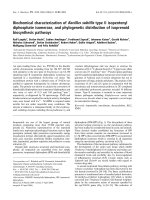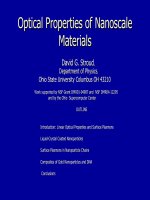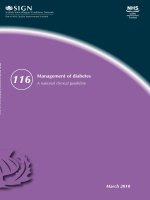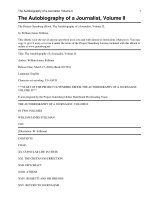prediction of diabetes mellitus type ii
Bạn đang xem bản rút gọn của tài liệu. Xem và tải ngay bản đầy đủ của tài liệu tại đây (1.15 MB, 48 trang )
PREDICTION OF DIABETES
PREDICTION OF DIABETES
MELLITUS TYPE II
MELLITUS TYPE II
-NEW DIAGNOSTIC PERSPECTIVES-
-NEW DIAGNOSTIC PERSPECTIVES-
!"#$###
%%#%&
#%%'(%&
)% %$
%#%
&'!*+*(*"++,*-+.'/
* Costly healthcare burden and a major cause of morbidity and mortality
due to
%%
%%
• T2D –common endocrine disease strongly determined by inheritable
factors, is likely polygenic
• Develops from chronic and progressive loss of insulin secretion on a
background of chronic and often progressive insulin resistance
• Hepatic glucose overproduction and diminished glucose uptake by
muscle tissues
• Reduced insulin and increased glucagon secretion
• Dyslipidemia
• Reduced GLP-1 release, diminished incretin response
'!*+*(*""++,*-+.'/
(0112+0101+.'
3
-% # /
-% # /
3
0 -
0 -
4
4
.56 # 7
.56 # 7
4
4
.8
.8
#9./
#9./
-
-
Sedentary life style, active and passive smoking)
Sedentary life style, active and passive smoking)
3
1#
1#
-
-
eg, African American, Hispanic American, Native American,
eg, African American, Hispanic American, Native American,
Asian
Asian
American, Pacific Islander)
American, Pacific Islander)
3
#
#
4
4
:;
:;
)%-
)%-
4
4
<:59=5)#/
<:59=5)#/
3
)%%
)%%
)'"
)'"
>
>
?5&=59"@
?5&=59"@
#
#
4
4
?.&A.9"@
?.&A.9"@
3
)#
)#
-
-
:&<#/
:&<#/
3
%##%#
%##%#
• %# ( responsible for the predominance of one
mechanism over the other).
• *
•B7 has been shown to contribute to the development of
insulin resistance and impaired insulin secretion in animal models of
diabetes
• )%# is responsible for some of the resistance and some of
the impairment in beta-cell function
•"%7
+010C+1!+CB+0+)*"0
+010C+1!+CB+0+)*"0
0
0
!*+*""C+0CC'
!*+*""C+0CC'
C"C1*+C*
C"C1*+C*
C1*+C)01(0C*
*B"
• Increase in cell proliferation
• Stimulation of insulin synthesis
• Increase in beta cell mass
• Preservation of cells(animals)
D
D
iabetes
iabetes
type II
type II
– Is
– Is
prevention possible
prevention possible
1.Understanding the relationship between clinical progression(based on
circulating glucose levels) and biological progression (based largely on
changes in the relationship between insulin supply and demand) of the
disease
.
.(Assesment of insulin resistance and beta cell function)
Possible approach: intravenous glucose tolerance test
2.Recognition of prediabetes and early diabetes phase (due to
asymptomatic preclinical phase of disease)
• Detection of loss of first-phase insulin release (point at which glucose
intolerance begins to develop)
•
D
D
iminished
iminished
%
%
is an early marker of beta
is an early marker of beta
cell
cell
dysfunction,
dysfunction,
appearing long before significant changes in absolute
appearing long before significant changes in absolute
glucose concentrations are apparent
glucose concentrations are apparent
•Elevated postprandial glucose concentrations in these individuals,
despite relatively normal fasting glucose levels
•Independant risk factor for cardiovascular disease
•Increases earlier and faster than plasma glucose levels
•Contributes more to HbA1c than to fasting glucose at A1c levels below
8,5%
•Rate limiting factor for achieving adequate glycemic control
)
)
•Endothelial dysfunction •Increase in oxidative stress
•Increases the inflammatory milieu •Increase in protein glycosylation
•Coagulation affected
0+1C'"),*1B",*(
+C'1'1**1*C*+*+C
+C'1'1**1*C*+*+C
'BC0
'BC0
•The fasting plasma glucose (FPG) test (7 mmol/L)
• 2-hour postload plasma glucose test (11,1 mmol/L)
-!D/
• Hemoglobin A1c
'<==8'BC0+1+*1
01+.'
•Symptoms of diabetes RPG > (11.1 mmol/L)
FPG > (7.0 mmol/L)
• 2-hour plasma glucose > (11.1 mmol/L) during an OGTT
• FPG, OGTT, oral glucose tolerance test; RPG
Debate:
FPG or OGTT
FPG or OGTT
?
?
W
W
hich is
hich is
a
a
better predictor of diabetic
better predictor of diabetic
complications
complications
???
???
# confirmatory test needed (FPG or OGTT
RPG when symptoms related to diabetes are present
*
E
E
(rule out diabetes with a good certainty. poor positive predictive values)
F
#%#
#%#
-B/
-B/
ADA- the screening test of choice
F
F
1
1
%#
%#
-1B
-1B
)
)
(measuring plasma glucose without regard to the last food intake).
1B-A&=9"
1B-A&=9"
) or above to be
) or above to be
*
*
0#
0# -0B++/
(. ingestion of a glucose load of 75 g a plasma glucose value of <<&<9") or more is
abnormal
F
F
B#
B#
-) <
-) <
)
)
Different cutoofs(
Different cutoofs(
HBA1c value of 7.0%
HBA1c value of 7.0%
,
,
as the cutoff for detecting "treatment-requiring diabetes
as the cutoff for detecting "treatment-requiring diabetes .,other
suggestions 6,5%,6%
: % <% %#
## #
## #
GGG
GGG
1**CCB
1**CCB
01+,*'!*+*
01+,*'!*+*
10!"*(1*"+*'+01**CCB
10!"*(1*"+*'+01**CCB
3
3Population MUST have one or more indications for screening
•Choice of screening test:
B1B
B1B, rarely HbA1c
•Current screening methods for type 2 diabetes and pre-
diabetes are inadequate
•Problems related to their inconvenience and inaccuracy









